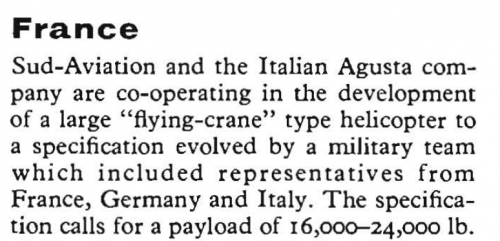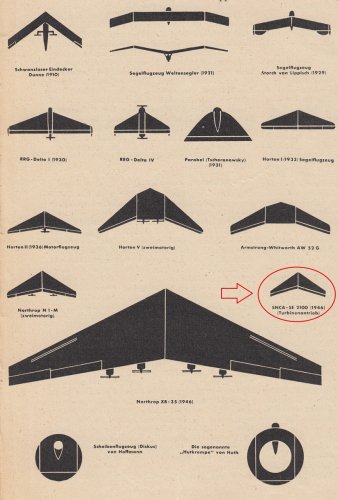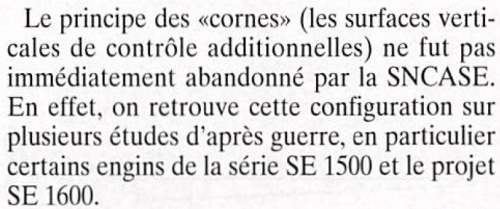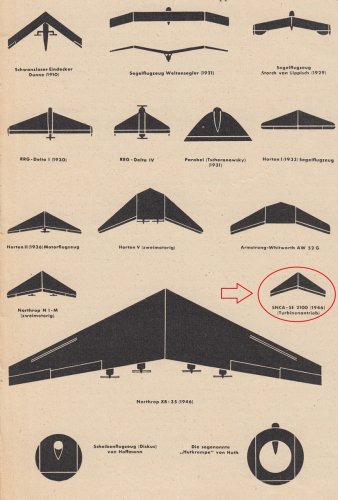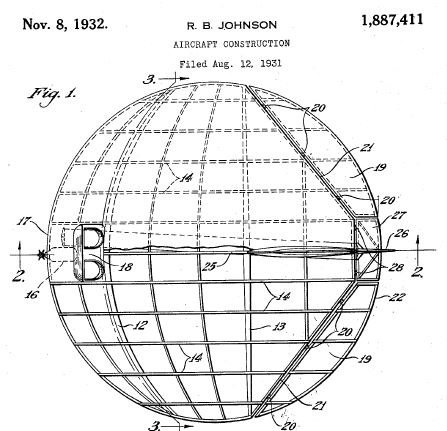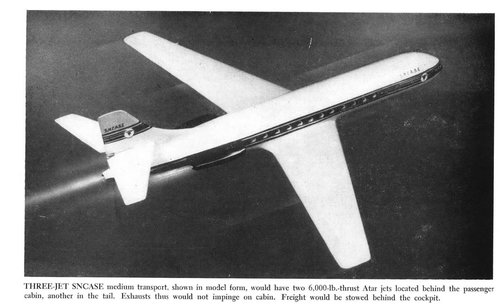You are using an out of date browser. It may not display this or other websites correctly.
You should upgrade or use an alternative browser.
You should upgrade or use an alternative browser.
SNCASE / Sud-Est Aviation designation (SE)
- Thread starter AM
- Start date
M
MilwaukeeRoad
Guest
SNCASE (Sud-Est) SE. X.210 « Caravelle » projects
http://www.secretprojects.co.uk/forum/index.php/topic,4926.0broken link, it seems.
- Joined
- 26 May 2006
- Messages
- 34,869
- Reaction score
- 15,733
Hi,
in 1959 Sud-Aviation and Agusta co-operated to develop a large flying crane helicopter,
also Germany was involved (may be by Merckle),and I suggest this project from Merckle,
and for Merckle,its only my opinion,no evidence about this company.
Air Pictorial September 1959
in 1959 Sud-Aviation and Agusta co-operated to develop a large flying crane helicopter,
also Germany was involved (may be by Merckle),and I suggest this project from Merckle,
and for Merckle,its only my opinion,no evidence about this company.
Air Pictorial September 1959
Attachments
- Joined
- 11 March 2006
- Messages
- 8,624
- Reaction score
- 3,792
Please, this section is for posting designations of aviation companies and maybe for discussions
or speculations about designations. In this case we have NO designation in relation with SNCASE /
Sud-Est Aviation at all and the photos of Meckle designs we already had here http://www.secretprojects.co.uk/forum/index.php/topic,17746.msg188480.html#msg188480
So, in alteration of an old phrase: Keep the threads tidy !
or speculations about designations. In this case we have NO designation in relation with SNCASE /
Sud-Est Aviation at all and the photos of Meckle designs we already had here http://www.secretprojects.co.uk/forum/index.php/topic,17746.msg188480.html#msg188480
So, in alteration of an old phrase: Keep the threads tidy !
M
MilwaukeeRoad
Guest
still broken, it seems.MilwaukeeRoad said:SNCASE (Sud-Est) SE. X.210 « Caravelle » projects
http://www.secretprojects.co.uk/forum/index.php/topic,4926.0broken link, it seems.
- Joined
- 25 June 2009
- Messages
- 14,749
- Reaction score
- 6,112
The topic is nowhere to be found. Either it was merged with another topic or lost in a failed merge back when I was a moderator and set about to merge a lot of isolated "orphan" topics.
This kind of thing is not supposed to happen, for sure. But when a moderator merges two topics, the new merged topic doesn't automatically take the number of the older one, it depends on which you selected first in the merging operation. By keeping track of the wrong number (the deleted topic) for a second merge afterwards, I may have merged the topic with... nothing. Asking the interface to merge an existing topic with a non-existing one ought to result in an error message, but I have a hunch it didn't because I never saw any such messages from the server when I merged things around. And so, perhaps the topic disappeared into oblivion instead...
What's worse is that it may have happened, not just to this topic, but also a handful of others, until I came to realize the existence of that problem. Theoretically it would be possible to retrieve the lost posts from the backups that are automatically made, but I do not know if Paul_MM has kept all the backups since Day 1 or if the new ones automatically replace the old ones after a while.
This kind of thing is not supposed to happen, for sure. But when a moderator merges two topics, the new merged topic doesn't automatically take the number of the older one, it depends on which you selected first in the merging operation. By keeping track of the wrong number (the deleted topic) for a second merge afterwards, I may have merged the topic with... nothing. Asking the interface to merge an existing topic with a non-existing one ought to result in an error message, but I have a hunch it didn't because I never saw any such messages from the server when I merged things around. And so, perhaps the topic disappeared into oblivion instead...
What's worse is that it may have happened, not just to this topic, but also a handful of others, until I came to realize the existence of that problem. Theoretically it would be possible to retrieve the lost posts from the backups that are automatically made, but I do not know if Paul_MM has kept all the backups since Day 1 or if the new ones automatically replace the old ones after a while.
- Joined
- 26 May 2006
- Messages
- 34,869
- Reaction score
- 15,733
Don't worried MilwaukeeRoad,
I have a file,contains all Caravelle most of Caravelle aircraft and projects,and I repeat
many of them in this topic;
http://www.secretprojects.co.uk/forum/index.php/topic,20430.0.html
I have a file,contains all Caravelle most of Caravelle aircraft and projects,and I repeat
many of them in this topic;
http://www.secretprojects.co.uk/forum/index.php/topic,20430.0.html
Skyblazer said:SE 4100 first French missile, project only
[...]
SE 4300 variant of SE 4100 with French radar
[...]
(unknown designation) CASSEUR ground-to-ground ballistic missile (SSBT) project with 100 kms range (1956-57)
SE.4100 was not a project only, 81 were built in 18 variants, powered by an SEPR 2 rocket engine.
SE.4300 was a different ground-to-air missile.
The "Casseur" was X-407 by Sud-Aviation.
The X-408 was the VE 10 Aigle rocket.
The X-411 to X-421 were projects of a ramjet-powered cruise missile, and the X-422 was a half-scale demonstrator built in 3 examples.
The X-423 was an anti-ship missile that became the Exocet.
Source: http://www.cannes-aero-patrimoine.net/pdf/pub/caspk_APADH__005_Jung_His_Cannes.pdf
- Joined
- 25 June 2009
- Messages
- 14,749
- Reaction score
- 6,112
c460 said:SE.4100 was not a project only, 81 were built in 18 variants, powered by an SEPR 2 rocket engine.
Yeah, I never updated that list but since then I found that the SE.4100 of 1949 (a.k.a. SA 10) was actually the first French missile, based on the German Hs.117 and studied from 1946 onwards, starting life as the NC 3500.
c460 said:SE.4300 was a different ground-to-air missile.
It's strange because I've got it as a 1954 variant of the SE 4100 with a French radar (a.k.a. SA 11) (approximately 175 built).
This being said, another source gave it as a "post-war surface-to-air missile based on the German Rheintochter". If so, what was the correct SE designation for the SA 11?
As for the Casseur, I also have it as the SE 4500.
Thanks a lot for the X.4** series designations!
Skyblazer said:It's strange because I've got it as a 1954 variant of the SE 4100 with a French radar (a.k.a. SA 11) (approximately 175 built).
This being said, another source gave it as a "post-war surface-to-air missile based on the German Rheintochter". If so, what was the correct SE designation for the SA 11?
The SE.4300 was indeed SNCASE's offer for the SA.11 program. I'm not sure if it was closely related to the SE.4100. I understand that at least the propulsion system was different, with an SEPR 2 rocket on the SE.4100, and an ECAN Maruca rocket on the SE.4300.
There's an article about this missile in Trait d'Union no.211, again by Philippe Jung. It says that 86 examples of the SE.4300 were built, then 150 examples of the variant SE.4350 were ordered, of which about 89 were built.
From the article linked above, it is pretty clear that those were very different: the SE.4500 was a ramjet-powered subsonic cruise missile, whereas the Casseur was a ballistic missile with aerodynamic controls for the re-entry phase.Skyblazer said:As for the Casseur, I also have it as the SE 4500.
Adrien
- Joined
- 25 June 2009
- Messages
- 14,749
- Reaction score
- 6,112
c460 said:From the article linked above, it is pretty clear that those were very different: the SE.4500 was a ramjet-powered subsonic cruise missile, whereas the Casseur was a ballistic missile with aerodynamic controls for the re-entry phase.
Fair enough: on closer inspection I have the SE 4500 as the X.405, and the Casseur as the X.407, so obviously they couldn't be one and the same.
- Joined
- 12 July 2006
- Messages
- 948
- Reaction score
- 742
U.W.Jack sent me an overview of different flying wings, published in the 1952 magazine Mechanikus - thanks a lot, Uwe.
You can see the Sud-Est SE.2100. I know this aircraft as a small one with piston engine for pusher propeller. But the caption is SNCA-SE 2100 (1946) (Turbinenantrieb). Last word means 'jet propulsion'. Is this totally wrong or did such a conversion from piston to jet engine exist on the drawing board? Any hints?
You can see the Sud-Est SE.2100. I know this aircraft as a small one with piston engine for pusher propeller. But the caption is SNCA-SE 2100 (1946) (Turbinenantrieb). Last word means 'jet propulsion'. Is this totally wrong or did such a conversion from piston to jet engine exist on the drawing board? Any hints?
Attachments
- Joined
- 11 March 2006
- Messages
- 8,624
- Reaction score
- 3,792
The SE.2100 was designed by Pierre Satre, a SNCASE test pilot, during WW II and realised during
1945 ( see http://www.twitt.org/satre.htm#top ). It featured a tricycle landing gear for a low entrance,
so it seems to have been intended really just as a light transport, not as a kind of test bed. And that
drawing states the year 1946, when the SE.2100 was still existing. So a double use of that designation
seems not very probable to me.
Some of the designs shown in the sketch weren't flying wings, but tailless, still fitted with fins and
those fins are recognisable, e.g. in the case of the RRG Delta or the Lippisch Storch. Additionally
in prop driven types, the props are shown, but in the case of SE.2100 is neither.
Have googled for the Mechanikus magazine, a publication for "tinkerer and inventors", as it was advertised,
a kind of German equivalent to Popular Mechanics, maybe with a little more emphasis to "tinkering" (sorry
for that ), judging the covers, that often show some kind of models, either of ships, aircraft or railways.
), judging the covers, that often show some kind of models, either of ships, aircraft or railways.
So to my opinion, it's not the most reliable source for real aircraft. I can imagine, that for example a wind
tunnel model of the wing of the SE.2100, without fuselage and prop then, could have led to that entry
in the drawing.
1945 ( see http://www.twitt.org/satre.htm#top ). It featured a tricycle landing gear for a low entrance,
so it seems to have been intended really just as a light transport, not as a kind of test bed. And that
drawing states the year 1946, when the SE.2100 was still existing. So a double use of that designation
seems not very probable to me.
Some of the designs shown in the sketch weren't flying wings, but tailless, still fitted with fins and
those fins are recognisable, e.g. in the case of the RRG Delta or the Lippisch Storch. Additionally
in prop driven types, the props are shown, but in the case of SE.2100 is neither.
Have googled for the Mechanikus magazine, a publication for "tinkerer and inventors", as it was advertised,
a kind of German equivalent to Popular Mechanics, maybe with a little more emphasis to "tinkering" (sorry
for that
So to my opinion, it's not the most reliable source for real aircraft. I can imagine, that for example a wind
tunnel model of the wing of the SE.2100, without fuselage and prop then, could have led to that entry
in the drawing.
- Joined
- 26 May 2006
- Messages
- 34,869
- Reaction score
- 15,733
hesham said:X-316 was a twenty three seat commercial and military transport helicopter project of 1955.
The X.316 was the early design for SA.3200 Frelon.
http://de.wikipedia.org/wiki/A%C3%A9rospatiale_SA_321
- Joined
- 3 September 2006
- Messages
- 1,474
- Reaction score
- 1,468
Very light light transport, then. It was a 2-seater touring plane.Jemiba said:The SE.2100 was designed by Pierre Satre, a SNCASE test pilot, during WW II and realised during
1945 ( see http://www.twitt.org/satre.htm#top ). It featured a tricycle landing gear for a low entrance,
so it seems to have been intended really just as a light transport, not as a kind of test bed.
- Joined
- 26 May 2006
- Messages
- 34,869
- Reaction score
- 15,733
Hi,
for SNCASE,Sud-Aviation & Aerospatiale X series,we can find them under six main series;
- X-100 and was raising up to X-116,X-117,X-118,later redesigned as SE.116,SE.117 & SE.118,continued
to X-121,X-125 (SA-125) and later X-137
- X-200 and raised up to X-210 later redesigned as SE.210,X-211,X-212 later redesigned into SE.212,
continued to X-220,X-221 ....X-224,no record for X-225 to X-229,X-230 up to X-380.
- X-300 for helicopters,up to X-326
- X-400 for missiles
- X-100 passing with X-600,X-700 & X-800,for X-100 is only my suggesting.
- X-900 for STOL & VTOL aircraft,X-904 later redesigned into Aerospatiale A-904,and raised
up to X-910
Any additions or corrections are welcome.
for SNCASE,Sud-Aviation & Aerospatiale X series,we can find them under six main series;
- X-100 and was raising up to X-116,X-117,X-118,later redesigned as SE.116,SE.117 & SE.118,continued
to X-121,X-125 (SA-125) and later X-137
- X-200 and raised up to X-210 later redesigned as SE.210,X-211,X-212 later redesigned into SE.212,
continued to X-220,X-221 ....X-224,no record for X-225 to X-229,X-230 up to X-380.
- X-300 for helicopters,up to X-326
- X-400 for missiles
- X-100 passing with X-600,X-700 & X-800,for X-100 is only my suggesting.
- X-900 for STOL & VTOL aircraft,X-904 later redesigned into Aerospatiale A-904,and raised
up to X-910
Any additions or corrections are welcome.
- Joined
- 3 September 2006
- Messages
- 1,474
- Reaction score
- 1,468
Almost, but the reverse: SE.1040 experimental machine meant to test engine performance for the SE X-111 project.hesham said:X-111 was a four engined transport aircraft test model Project,intended to
study the performance for SE.1040.
richard B
ACCESS: Secret
- Joined
- 17 August 2006
- Messages
- 343
- Reaction score
- 498
boxkite said:U.W.Jack sent me an overview of different flying wings, published in the 1952 magazine Mechanikus - thanks a lot, Uwe.
You can see the Sud-Est SE.2100. I know this aircraft as a small one with piston engine for pusher propeller. But the caption is SNCA-SE 2100 (1946) (Turbinenantrieb). Last word means 'jet propulsion'. Is this totally wrong or did such a conversion from piston to jet engine exist on the drawing board? Any hints?
Mechanikus overview is interesting .
Do you know more about the Diskus Scheibenflugzeug of Hoffmann (buttom left)? I can't find anything for it ...
Attachments
Deltafan
ACCESS: Top Secret
- Joined
- 8 May 2006
- Messages
- 1,695
- Reaction score
- 2,303
Maybe :richard B said:Do you know more about the Diskus Scheibenflugzeug of Hoffmann (buttom left)? I can't find anything for it ...
https://en.wikipedia.org/wiki/Raoul_Hoffman
https://www.manmade-ufos.com/arup
Retrofit
ACCESS: Top Secret
- Joined
- 21 February 2007
- Messages
- 656
- Reaction score
- 337
richard B said:Mechanikus overview is interesting .
Do you know more about the Diskus Scheibenflugzeug of Hoffmann (buttom left)? I can't find anything for it ...
It seems more related to the Richard Johnson "Uniplane" tested between 1934 and 1936.
Extract of his patent here-under:
Attachments
- Joined
- 25 July 2007
- Messages
- 4,299
- Reaction score
- 4,193
Skyblazer said:...
SE-580 — Fighter Aircraft Project derived from Dewoitine D-520, with dorsal air intake SE-581 — Fighter Aircraft Project derived from Dewoitine D-520, with dorsal air intake SE-582 — Fighter Aircraft
A few details on the SE 580 and related projects. The original SE 580 concept shared its layout with the SNCAM M 580 - being a tandem-twin (HS 12Zs arranged à la Arsenal VB 10) - but not its exact airframe shape. This evolved into the more familiar single HS 24Z-powered SE 580 as built.
The SE 580 variant was, of course, intended for the Armée de l'air. The SE 581 was a divebomber proposal based upon the SE 580 (which was not taken up). The SE 582 was a hooked shipboard development of the SE 580 for the Aéronavale with folding-wings and other naval equipment. Work was begun on SE 582 components but no example of the naval fighter was ever completed.
Ali nuove 1962, 'I Caccia Dewoitine: 5° Parte', Giorgio Bignozzi, page 128
- Joined
- 26 May 2006
- Messages
- 34,869
- Reaction score
- 15,733
Some Corrections from The Aviation Historian 25,
SE-1020 was a maritime-patrol version equipped with gun-turrets
SE-1030 & SE-1035 were a stratosphere transport variants,with wider fuselage
SE-1040 was a version powered by four Rolls-Royce Dart turboprop engine
SE-1020 was a maritime-patrol version equipped with gun-turrets
SE-1030 & SE-1035 were a stratosphere transport variants,with wider fuselage
SE-1040 was a version powered by four Rolls-Royce Dart turboprop engine
- Joined
- 12 July 2006
- Messages
- 948
- Reaction score
- 742
There was another project to fit the SE.2010 Armagnac with turboprop engines: the SE.2043, designed for installation of Bristol Proteus engines.
Source: 'SE 2010 Armagnac - le géant oublié' by Laurent Gruz (ISBN 978-2-9537763-0-0) - p102-109
Source: 'SE 2010 Armagnac - le géant oublié' by Laurent Gruz (ISBN 978-2-9537763-0-0) - p102-109
- Joined
- 26 May 2006
- Messages
- 34,869
- Reaction score
- 15,733
Hi,
SE.2600 was a missile of 1947.
 docplayer.fr
docplayer.fr
SE.2600 was a missile of 1947.
ProtectedPool ➤ Most Powerful and Safest Web3 Smart DeFi Wallet
ProtectedPool ➤ Web3 Smart DeFi Wallet . Your New DeFi Experience:: Secure, Smart, Simple. Double Approvals. Add extra confirmation of any transaction with 2FA solutions including Google Authenticator or hardware security keys. Self-custodial Solutions. Protected Pool is built on smart...
Bazinga
I really should change my personal text
- Joined
- 14 December 2012
- Messages
- 292
- Reaction score
- 406
- Joined
- 26 May 2006
- Messages
- 34,869
- Reaction score
- 15,733
Could this be the SE X-250? Something of a design evolution of the SE-210 Caravelle. Ultimately the Caravelle Horizon was proposed but superseded by the Super Caravelle SST. She seems too small for the 30p SE X-205. 1952 AW&ST source.
No it was not,here is the X-250;
Bazinga
I really should change my personal text
- Joined
- 14 December 2012
- Messages
- 292
- Reaction score
- 406
OK, which one is this one then? There are not many 3 jet versions in 1952. This is a 3 jet Caravelle?Could this be the SE X-250? Something of a design evolution of the SE-210 Caravelle. Ultimately the Caravelle Horizon was proposed but superseded by the Super Caravelle SST. She seems too small for the 30p SE X-205. 1952 AW&ST source.
No it was not,here is the X-250;
- Joined
- 26 May 2006
- Messages
- 34,869
- Reaction score
- 15,733
It was X-205,and not X-250,please see;
Similar threads
-
SNCASE (Sud-Est) SE.1200 helicopter project
- Started by hesham
- Replies: 3
-
-
-
-

